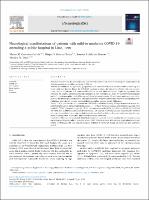| dc.contributor.author | Carcamo Garcia, Marco H. | |
| dc.contributor.author | Garcia Choza, Diego D. | |
| dc.contributor.author | Salazar Linares, Brenda J. | |
| dc.contributor.author | Diaz, Monica M. | |
| dc.date.accessioned | 2023-03-23T21:50:56Z | |
| dc.date.available | 2023-03-23T21:50:56Z | |
| dc.date.issued | 2021-06 | |
| dc.identifier.citation | eNeurologicalSci. 2021;23. | es_PE |
| dc.identifier.issn | 2405-6502 | |
| dc.identifier.uri | https://hdl.handle.net/20.500.12959/3508 | |
| dc.description.abstract | Objective
To determine the prevalence and characteristics of the most common neurological manifestations in Peruvian patients with mild-to-moderate COVID-19.
Methods
We conducted a single-center prospective, cross-sectional study at an isolation center functioning as a public acute-care hospital during the COVID-19 pandemic in Lima, the capital city of Peru. This was a convenience sample of patients with acute COVID-19 infection and mild-to-moderate respiratory symptoms who presented for hospital admission between September 25 and November 25, 2020. We interviewed participants and collected demographic, medical history and clinical presentation data; all participants underwent a complete physical and neurological examination. Descriptive statistics and prevalence ratios (PR) with corresponding 95% confidence intervals and p-values were calculated to explore between-groups differences.
Results
Of 199 patients with mild-to-moderate COVID-19 enrolled in this study, 83% presented with at least one neurological symptom (mean symptom duration 8 +/− 6 days). The most common neurological symptoms were headache (72%), hypogeusia or ageusia (41%), hyposmia or anosmia (40%) and dizziness (34%). Only 2.5% of the cohort had an abnormal neurological examination. The majority (42%) had no prior comorbidities. Presence of at least 1 neurological symptom was independently associated with fever, dyspnea, cough, poor appetite, sore throat, chest tightness or diarrhea, but not with comorbid conditions.
Conclusions
This cross-sectional study found that headaches, and smell and taste dysfunction are common among patients presenting with mild-to-moderate acute COVID-19 in Lima, Peru. International longitudinal studies are needed to determine the long-term neurological sequelae of COVID-19 during the acute and post-infectious period. | es_PE |
| dc.format | application/pdf | es_PE |
| dc.language.iso | eng | es_PE |
| dc.publisher | World Federation of Neurology | es_PE |
| dc.relation.uri | https://www.sciencedirect.com/science/article/pii/S2405650221000307 | es_PE |
| dc.rights | info:eu-repo/semantics/openAccess | es_PE |
| dc.rights.uri | https://creativecommons.org/licenses/by-nc-sa/4.0/ | es_PE |
| dc.subject | Covid-19 | es_PE |
| dc.subject | Neurological | es_PE |
| dc.subject | Headache | es_PE |
| dc.subject | Latin America | es_PE |
| dc.subject | Neurología | es_PE |
| dc.subject | Dolor de cabeza | es_PE |
| dc.subject | América Latina | es_PE |
| dc.subject | Perú | es_PE |
| dc.title | Neurological manifestations of patients with mild-to-moderate COVID-19 attending a public hospital in Lima, Peru | es_PE |
| dc.title.alternative | Manifestaciones neurológicas de pacientes con COVID-19 leve a moderado que asisten a un hospital público de Lima, Perú | es_PE |
| dc.type | info:eu-repo/semantics/article | es_PE |
| dc.subject.ocde | https://purl.org/pe-repo/ocde/ford#3.02.25 | es_PE |
| dc.identifier.doi | https://doi.org/10.1016/j.ensci.2021.100338 | |






